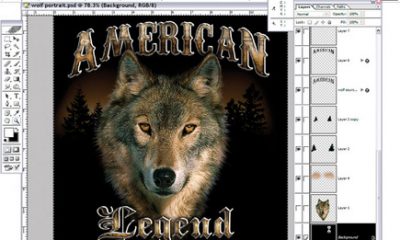Digital Printing
Published
15 years agoon
I’ve been thinking lately about what kind of year 2008 was and what kind of year 2009 will be. Few would deny that 2008 was a rough one. Many real estate markets, the stock market, and the overall economy were all terrible. Now unemployment is way up. On the other hand, exports are strong, fuel prices are half of what they were just a few months ago, and we have a new president.
Despite the tough economy, last year did see some big, new developments in the market for wide-format digital printing. There is no doubt in my mind that we’re seeing the dawn of automation in wide-format digital. New, high-speed printer models from EFI-VUTEk (the DS-series), HP (the HP TJ7550), and Inca Digital (Onset S20) all have automated feeding mechanisms that dramatically increase productivity. These are all very high-end wide-format digital printing devices, but I believe we’re going to see some of this type of functionality make it into lower levels of equipment soon. I also think we’re going to see a lot more attempts to automate on the finishing side soon.
Another area in which there’s a lot of interest and development is the enhancement and improvement in printer service. Mutoh recently announced that it would start including a webcam with every printer. This would allow dealers who service the equipment to remotely diagnose problems with the printer or software. Durst is another company that has created innovative printer-service capabilities. Durst’s system lets users log in and view video clips of maintenance and repair procedures so they can perform these procedures themselves and increase up time.
In 2008, I had quite a few printing establishments tell me that they were getting out of solvent ink printing—specifically, they were going to retire their grand-format solvent inkjets, but not for green purposes. They were going to do it because between the new UV ink formulations that work better with flexible substrates, and new grayscale printheads that use the ink more efficiently, they were getting into UV-curable inkjet for running cost advantages.
Last year will go down in my mind as the year that substrate suppliers really made the rubber hit the road with green products. From textiles, which were red hot all year, to rigid substrates—and even some finishing materials—we saw tons of new green print-media options hit the market in 2008.
Speaking of green initiatives, fantastic progress has been made in the development of green standards and practices by the Sustainable Green Printing (SGP) Partnership. If you aren’t familiar with this group, check out their Website at www.sgppartnership.org. This group has not only developed a set of standards, but they have also reached out to multiple printing-industry associations as partners and supporters to help keep the initiative moving forward. As of this writing, the SGP Partnership includes Printing Industries of America/Graphic Arts Technical Foundation (PIA/GATF), Specialty Graphic Imaging Association (SGIA), Flexographic Technical Association (FTA), National Association of Printing Ink Manufacturers (NAPIM), Envelope Manufacturers Association (EMA), and the Foil Stamping & Embossing Association (FSEA).
In 2008 we also saw the acquisitions of Raster Printers Inc. and L&P Digital. I think there consolidation will continue in the UV-curable-inkjet market in 2009. I also believe we will see as many as six more of the three dozen global suppliers of UV-curable inkjet printers either be acquired or just drop out of this segment of the market. At the same time, I expect that there will be even more attempts by Asian suppliers to penetrate the US market, especially considering the efforts under way in China to outdoor advertising.
I am very interested to see how KIP does in 2009 with their wide-format color-toner device now that it is available. At Graph Expo, the company was positioning the KIP Color 80 more or less the same way that Océ had positioned the Océ ColorWave 600, as both a technical and graphics printer. These printers are pretty expensive, with prices ranging from $80,000 up to more than $120,000—but for a certain segment of the market, reprographics companies in particular, I can understand the appeal of these printers based on their speed and running costs.
There was some talk at SGIA that HP’s Latex ink technology is still basically a solvent ink technology. HP’s representatives vigorously deny this and are more than willing to provide technical information to refute that opinion to anyone who requests it. Basically, there is a co-solvent in the ink, but it is the same level of co-solvent that is in the water-based inks HP uses in its DesignJet aqueous inkjet printers. There are other durable aqueous inkjet printing solutions and systems that will compete with HP’s Latex printing systems in what amounts to a new equipment category in 2009.
Looking ahead
InfoTrends publishes market forecasts every year about the wide-format-digital market; hardware, ink, and media volumes; and value projections. Right now we project the worldwide market for wide-format graphics will grow from $55 billion in 2008 to $67 billion in 2012 for a compound annual growth rate of 6.0%. So we still see wide-format digital as a growing market with profitable growth and some dynamic emerging applications.
That said, just about every one of the vendors that I spoke to reported that printer shipments were down from 2007 levels, and lots of our end-user data suggest that they would postpone equipment purchases until the economic outlook improves. Clearly the economy is having an impact on the market for wide-format graphics, but it is very difficult to predict the total of that impact and how long it will last. As famous economist John Kenneth Galbraith wrote, “The only function of economic forecasting is to make astrology look respectable.” So, we’re building our forecast models using the fundamental assumptions that have fueled the growth of the market in the past, namely the strength of trade shows and events, and outdoor and point-of-purchase advertising.
As part of these projections, we consider a set of what I call risk factors, or developments that could significantly disrupt the market. These risk factors range from the overall economy and the cost of ink in the screen-printing and digital-imaging markets due to raw materials costs increases and the emergence of digital displays that are carving into the volume of billboards that get printed. There were many announcements from industry leaders in 2008 that the price of inks in the screen-printing and offset-printing markets would increase. On the digital side, I build in price declines on an annual basis, which is what we have typically seen as technology platforms develop and third-party ink suppliers offer inks that reduce the cost of digital printing. We’re already aware of several suppliers of wide-format printing systems that are launching lower priced inks for their platforms in 2009.
We’re also closely watching the growth of digital displays. Companies like Clear Channel and Lamar Advertising, the bellwethers of the outdoor advertising industry, indicate that digital-display revenues are growing while poster revenues were in decline in 2008.
It seems like the UK is kind of a hot-house anyway, but I’ve heard that in the UK, with print buyers pushing them for rock-bottom prices, the market for wide-format graphics has gotten so competitive that print providers are doing more of their work on their screen-printing equipment to achieve lower production costs. This has also created a large market for used digital imaging equipment.
In 2009 I expect to see more new specialty printing systems designed to appeal to specific applications. In 2007 and 2008, we saw new printers hit the market specifically for applications like ceramic and glass printing. These are enabled by inks that are highly adhesive and printheads that can jet those fluids effectively. Durst, GCC, Teckwin, and others launched application-specific printers in 2007 and 2008, and I think we’re going to see a lot more printers launched in 2009 that are designed for some of these rigid-substrate applications.
I’ve written in this column before that every segment of the screen-printing market (graphics, textiles, industrial, and specialty) seems to have some competition from digital printing and from inkjet in particular. I recently read about another inkjet-technology development—aerosol jetting—that very accurately jets drops of conductive fluids. These fluids are deposited in arrangements to create flat-panel displays, printed circuit boards, and RFID antennae. There are other inkjet initiatives in the deposition of these materials, but aerosol appears to have some inherent advantages in terms of dot-placement accuracy. Of course, piezoelectric inkjet drops are already extraordinarily small and placed incredibly accurately as well.
Finally, when people complain about a decision a company made or something a company did that is bad, like AIG or Lehman Bros., I try to remember that companies don’t do these things—for the better and for the worse, individual people run those companies and make those decisions. I think it is very important to try to remember that there are millions of other great individuals doing the exact opposite every day, dealing in good faith and honoring their commitments to employees, business partners, and clients. This is a great industry with an enormously high majority of the latter.
Have a comment about this article? E-mail it to the editors at screen@stmediagroup.com.
The opinions and recommendations expressed in this column are Mr. Greene’s and not necessarily those of Screen Printing magazine.
Tim Greene
Tim Greene has worked at InfoTrends (formerly known as CAP Ventures) since 1997 and has been the director of InfoTrends' Wide Format Printing Consulting Service since 2001. He is responsible for developing worldwide forecasts of the wide-format-printing market and conducting primary and secondary research. Greene holds a bachelor's degree in management from Northeastern University. He can be reached at tim_greene@infotrends.com.

Subscribe

Magazine
Get the most important news
and business ideas from Screenprinting Magazine.
Most Popular
-

 Art, Ad, or Alchemy1 month ago
Art, Ad, or Alchemy1 month agoF&I Printing Is Everywhere!
-

 Case Studies1 month ago
Case Studies1 month agoHigh-Density Inks Help Specialty Printing Take Center Stage
-

 Andy MacDougall1 month ago
Andy MacDougall1 month agoFunctional and Industrial Printing is EVERYWHERE!
-

 Columns2 weeks ago
Columns2 weeks ago8 Marketing Mistakes Not to Make When Promoting Your Screen Printing Services Online
-

 Editor's Note2 weeks ago
Editor's Note2 weeks agoLivin’ the High Life
-

 Thomas Trimingham2 months ago
Thomas Trimingham2 months ago“Magic” Marketing for Screen Printing Shops
-

 Marshall Atkinson2 weeks ago
Marshall Atkinson2 weeks agoHow to Create a Winning Culture in Your Screen-Printing Business
-

 News & Trends1 month ago
News & Trends1 month agoWhat Are ZALPHAS and How Can You Serve Them in Your Print Business?






